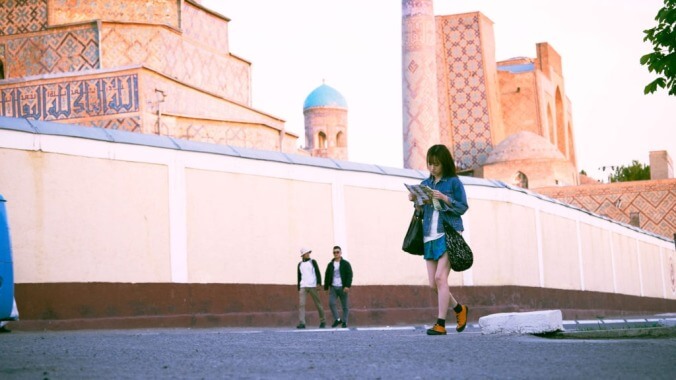A former pop star journeys To The Ends Of The Earth in Kiyoshi Kurosawa’s terrific new film


To The Ends Of The Earth is the sort of film that’s too easily tagged as a “departure” for its veteran director. Still best known in the U.S. for Cure and Pulse, Kiyoshi Kurosawa continues to be received as a prodigious horror stylist—an accurate if limited designation that has to do with selective Stateside distribution, and doesn’t fully account for how his work often resists easy classification, straddling disparate (and at times opposing) genres, tones, and moods. So while Kurosawa’s latest is a departure in the most literal sense, following a small Japanese film crew producing a travel variety show in Uzbekistan, it is nonetheless emblematic of the director’s ability to engender strange and surprising transformations in whatever material he’s working with. Beginning as an offbeat, fish-out-of-water travelogue, To The Ends Of The Earth gradually incorporates elements of an adventure movie, self-reflexive film shoot, and even musical melodrama. By the end, it’s no less than one of the most moving films Kurosawa has ever made.
At the center of this metamorphic journey is the travel program’s host, Yoko (Atsuko Maeda, formerly of the Japanese supergroup AKB48). With the help of Temur (Adiz Rajabov), their designated translator and guide, she and the all-male production crew travel from place to place, interacting with the locals, and filming the country’s varied attractions. Inevitably, these scenes trade on a sharp sense of dislocation. In some cases, there’s the expected culture-clash conflict, as when the group heads to Aydar Lake in search of a legendary fish called the bramul, and a local fisherman refuses to take Yoko on board his boat because she’s a woman. In others, there’s an added fiscal component, as when the frustrated crew, unable to get any other useful show material, buys a goat from a local family and films Yoko setting it free near a mountain range, only to have the very same family promptly swoop back in and retrieve the animal. Driven by a dynamic that’s all too familiar in tourism-dependent locations, such scenes are as amusing as they are discomfiting, and also make good use of the supporting cast. Shôta Sometani (First Love) is particularly good as the crew’s tetchy showrunner, who seems perpetually irritated that he can’t just throw money at every problem that comes their way. (That the film was a commission to commemorate diplomatic relations between Japan and Uzbekistan adds another layer.)
All this and more Yoko takes in stride, conveying only peppy professionalism in front of the camera even as her hosting duties require her to endure all manner of minor indignities (eating an insufficiently cooked local rice dish on camera) and physical trials (going on a carnival ride that seems closer to a G-force training exercise). It’s during her solitary, off-hours jaunts, though, that To The Ends Of The Earth becomes more than just an episodic, acutely observed look at an arduous film shoot. As Yoko loses herself in the labyrinthine streets of Tashkent and Samarkand, we are plunged into the psychological space of an alienated woman whose wanderings Kurosawa inflects with a sense of dread and paranoia that teases horror without quite tipping into it. As the film unfolds, we learn a bit about Yoko’s professional aspirations (her plans to become a singer when she returns to Japan) and personal life (her firefighter boyfriend back home), but these details seem hazy, far-off, insubstantial—unreal almost. As she drifts through the hard, physical realities of another country, it’s her immediate, resolutely interior journey that moves to center.
This aspect of the film takes sublimely literal form about halfway through, when Yoko happens upon Uzbekistan’s national opera house, the Navoi Theater. Drawn into the cavernous building by the faint sound of music, she walks through a series of imposing, ornately decorated chambers, which Kurosawa shoots identically, slowly tracking through each hallway as Yoko moves ever forward, as if hypnotized. She soon emerges into an empty theater, and then, as an orchestra appears out of nowhere, takes to the stage with a Japanese rendition of Edith Piaf’s “Hymne À L’amour.”
This stirring fantasy sequence is the emotional centerpiece of To The Ends Of The Earth, and as in any good musical, it expresses what Yoko is otherwise unable to. But what’s remarkable about the film is how Kurosawa modulates the intense emotions amid a variety of conflicting tones and moods, suspending Yoko’s soulful yearning between fear and exhaustion, empathy and paranoia, frustration and fascination. When Yoko is seen texting some unspecified person early on (we only later learn that she has a boyfriend), he shoots the scene as one would a ghost story, recalling Personal Shopper. And as in the little-seen Seventh Code—an hour-long, Vladivostok-set spy thriller that also stars Maeda and concludes with a bona fide music video—Kurosawa capitalizes on the actress’ unique physical presence, most notably during a chase sequence through Tashkent’s vast Chorsu Bazaar. If one persists in calling To The Ends Of The Earth a departure, then one might well marvel at how the Japanese director manages to stake out territory in so many different directions.
Toward the end, the film introduces a startling story turn befitting a melodrama, which finally allows Yoko’s largely subterranean emotional trajectory to blossom beyond the confines of fantasy. And as if in response, Kurosawa follows this by reaffirming yet another one of the film’s genre antecedents, observing as the production crew sets out for a new adventure, this time in the mountains of Zaamin. It is here that To The Ends Of The Earth fully reveals itself to be a quest for balance, following its heroine’s attempts to reconcile herself with the world at large, to find her footing even on foreign ground. For both Kurosawa and Maeda, the film’s conclusion is a resounding victory: At the ends of the earth, our heroine comes home to herself.